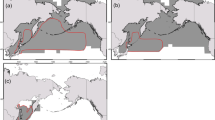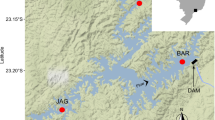Summary
Intraspecific predation is taxonomically widespread, but few species routinely prey on conspecifics. This is surprising as conspecifics could be a valuable resource for animals limited by food. A potential cost of cannibalism that has been largely unexplored is that it may enhance the risk of acquiring debilitating pathogens or toxins from conspecifics. We examined how pathogens affect variation in the incidence of cannibalism in tiger salamander larvae (Ambystoma tigrinum nebulosum), which occur as two environmentally-induced morphs, typicals and cannibals. Salamanders from one population were more likely than those in another to develop into cannibals, even when reared under identical conditions. Variation in the propensity to become a cannibal may be caused by variation in pathogen density. In the population with cannibals at low frequency, bacterial blooms in late summer correlated with massive die-offs of salamanders. The frequency of cannibals correlated significantly negatively with bacterial density in ten different natural lakes. In the laboratory, cannibals exposed to a diseased conspecific always preyed on the sick animal. As a result, cannibals wre more likely to acquire and die from disease than were typicals that were similarly exposed, or cannibals that were exposed to healthy conspecifics. Since conspecifics often share lethal pathogens, enhanced risk of disease may explain why cannibalism is generally infrequent. Pathogens may constrain not only the tendency to be behaviorally cannibalistic, but also the propensity to develop specialized cannibal morphologies.
Similar content being viewed by others
References
Anderson J (1990) Rangeland success on the Arizona Strip. In: Brock JH (ed) Proceedings of the First Conservation Symposium. [A] p 37
Anderson RM, May RM (1982) Population biology of infectious diseases. Springer, Berlin Heidelberg New York
bartlett MS (1971) The use of transformations. In: Steger JA (ed) Readings in statistics for the behavioral scientist. Holt, Rinehart and Winston, New York, pp 169–178
Berna HJ (1990) Ecology and life history of the tiger salamander Ambystoma tigrinum nebulosum Hallowell on the Kaibab Plateau. unpubl. MS thesis, Arizona State University, Tempe, AZ, pp 1–121
Brown DE (1982) Biotic communities of the American Southwest — United States and Mexico. Desert Plants 4:1–342
Collins JP (1981) Distribution, habitats and life history variation in the tiger salamander, Ambystoma tigrinum, in east central and southeast Arizona. Copeia 1981:666–675
Collins JP, Cheek JE (1983) Effect of food and density on development of typical and cannibalistic salamander larvae in Ambystoma tigrinum nebulosum. Am Zool 23:77–84
Collins JP, Holomuzki JR (1984) Intraspecific variation in diet within and between trophic morphs in larval tiger salamanders (Ambystoma tigrinum nebulosum). Can J Zool 62:168–174
Collins JP, Jones TR, Berna HJ (1988) Conserving genetically distinctive populations: the case of the Huachuca tiger salamander (Ambystoma tigrinum stebbinsi Lowe). In: Szarzo RC, Severson KC, Patton DR (eds) Management of amphibians, reptiles, and small mammals in North America. USDA Forest Service GTR-RM-166, Rocky Mountain Forest and Range Experiment Station, Fort Collins, CO
Collins JP, Mitton JB, Pierce BA (1980) Ambystoma tigrinum: a multispecies conglomerate? Copeia 1980:938–941
Crump ML (1983) Opportunistic cannibalism by amphibian larvae in temporary aquatic environments. Am Nat 121:281–289
Crump ML (1990) Possible enhancement of growth in tadpoles through cannibalism. Copeia 1989:794–797
Crump ML (1992) Cannibalism in amphibians. In: Elgar M, Crespi B (eds) Cannibalism: ecology and evolution among diverse taxa. Oxford University Press, New York (in press)
Eickwort KR (1973) Cannibalism and kin selection In Labidomera clivicollis (Coleoptera: Chrysomelidae). Am Nat 107:452–453
Green CR, Sellers WD (1964) Arizona climate. Univ Arizona Press, Tucson, AZ
Hoff GL, Hoff DM (1984) Salmonella and Arizona. In: Hoff GL, Frye FL, Jacobson ER (eds) Diseases of amphibians and reptiles. Plenum Press, New York, pp 69–82
Holomuzki JR (1986) Effect of microhabitat on fitness components of larval tiger salamanders, Ambystoma tigrinum nebulosum. Oecologia 71:142–148
Holomuzki JR, Collins JP (1987) Trophic dynamics of a top predator, Ambystoma tigrinum nebulosum (Caudata: Ambystomatidae), in a lentic community. Copeia 1987:949–957
Lannoo MJ, Bachmann MB (1984) Aspects of cannibalistic morphs in a population of Ambystoma t. tigrinum larvae. Am Midl Nat 112:103–109
Lively CM (1987) Evidence from a New Zealand snail for the maintenance of sex by parasitism. Nature 328:519–521
Mara BD (1974) Bacteriology for sanitary engineers. Longman, New York
Meffe GK, Crump ML (1987) Possible growth and reproductive benefits of cannibalism in the mosquitofish. Am Nat 129:203–212
Pedersen SC (1991) Dental morphology of the cannibal morph in the tiger salamander, Ambystoma tigrinum. Amphibia-Reptilia 12:1–14
Pfennig DW (1990) The adaptive significance of an environmentally-cued developmental switch in an anuran tadpole. Oecologia 85101–107
Polis GA (1981) The evolution and dynamics of intraspecific predation. Ann Rev Ecol Syst 12:225–251
Polis GA, Myers CA (1985) A survey of intraspecific predation among reptiles and amphibians. J Herp 19:99–107
Powers JH (1907) Morphological variation and its causes in Ambystoma tigrinum. Stud Univ Nebraska 7:197–274
Read AF (1988) Sexual selection and the role of parasites. Trends Ecol Evol 3:97–102
Rice RJ (1988) Fundamentals of geomorphology, 2nd ed. John Wiley and Sons, New York
Sherman PW (1981) Reproductive competition and infanticide in Belding's ground squirrels and other animals. In: Alexander RD, Tinkle DW (eds) Natural selection and social behavior. Chiron Press, New York, pp 311–331
Sprent JFA (1984) Ascaroid nematodes. In: Hoff GL, Frey FL, Jacobson ER (eds) Diseases of amphibians and reptiles. Plenum Press, New York, pp 219–245
Worthylake KM, Hovingh P (1989) Mass mortality of salamanders (Ambystoma tigrinum) by bacteria (Acinetobacter) in an oligotrophic seepage mountain lake. Great Basin Nat 49:364–372
Author information
Authors and Affiliations
Rights and permissions
About this article
Cite this article
Pfennig, D.W., Loeb, M.L.G. & Collins, J.P. Pathogens as a factor limiting the spread of cannibalism in tiger salamanders. Oecologia 88, 161–166 (1991). https://doi.org/10.1007/BF00320806
Received:
Accepted:
Issue Date:
DOI: https://doi.org/10.1007/BF00320806




